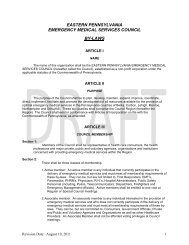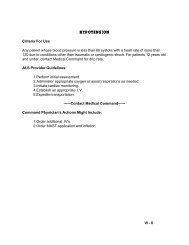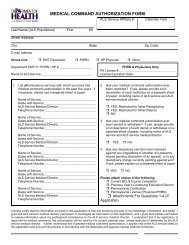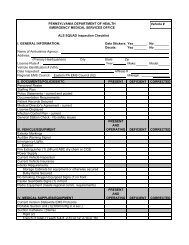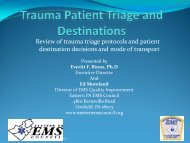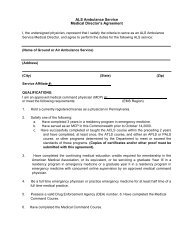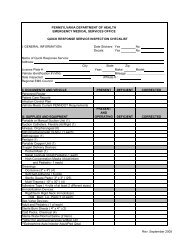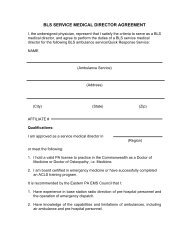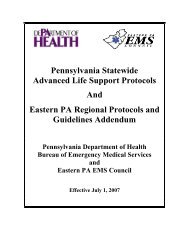Regional Diversion policy Jan 09.pdf - Eastern EMS Council
Regional Diversion policy Jan 09.pdf - Eastern EMS Council
Regional Diversion policy Jan 09.pdf - Eastern EMS Council
- No tags were found...
You also want an ePaper? Increase the reach of your titles
YUMPU automatically turns print PDFs into web optimized ePapers that Google loves.
<strong>Eastern</strong> PA <strong>EMS</strong> <strong>Council</strong><strong>Regional</strong> Hospital <strong>Diversion</strong> Policy and GuidelinesPurpose:To establish <strong>policy</strong> and guidelines for hospital diversions in the Countiesof Berks, Carbon, Lehigh, Monroe, Northampton, and Schuylkill.Objectives:1. Identify situations in which hospital facilities and/or resources are notavailable and temporary ambulance diversion is requested.2. Establish hospital diversion zones, based upon the generalgeographical location of the hospitals.3. Notify <strong>EMS</strong> services and personnel, both pre-hospital and hospital, ofthe diversion.4. Provide for the safe, appropriate and expedient care of patients whoenter the <strong>EMS</strong> system during the period of diversion.5. Terminate diversion by hospital(s) as appropriate and necessary.6. Establish specific categories and requirements for hospital diversion.Definitions:Behavioral Divert - temporary request for <strong>EMS</strong> ambulance by-pass due to aninflux of patients that require mental health evaluation or placement.Full Divert - temporary request for <strong>EMS</strong> ambulance by-pass due to an influx ofpatients presenting for treatment. Staffing is not an acceptable reason forrequesting diversion. If the Emergency Department has beds, then the hospitalwill continue to be open. <strong>EMS</strong> providers and practitioners retain the option oftransporting patients to diverting hospitals in specific cases, as outlined in theprocedures.Divert due to Internal Disaster - an event which prevents a hospital fromreceiving patients via ambulance. In order to use the Internal Disaster category,the hospital must have a true internal disaster such as electrical failure, flood, fire,etc.Revised December 2008 – effective <strong>Jan</strong>uary 20, 2009
Divert due to Major Equipment Failure - failure/inoperative equipment of oneor more of the following: ED X-ray, CT Scan, Cardiac Cath Lab. <strong>Diversion</strong>would only affect ambulances transporting patients that require the equipment thatis inoperative.Class 1 patient - Any patient deemed by the Paramedic and/or EMT responsiblefor patient care, to be hemodynamically unstable, and/or with respiratorycompromise, and/or otherwise unstable, despite receiving appropriate treatments.Process:1. When a hospital requests to divert patients, the Medical Command Physician,or his designee, on duty shall notify <strong>Eastern</strong> PA MedCom, via land linetelephone, of the type of divert requested and duration (not to exceed 4 hours).The MedCom Telecommunications Specialist will document the following foreach diversion request/cancellationa. Date and time of requestb. Name and MCP number of Medical Command Physician callingc. Type and duration of diversion requestedd. Problems/issues encountered by hospital/pre-hospital personnel.2. The MedCom Telecommunications Specialist shall ensure that each affectedcounty/counties is notified of the diversion (via the MedCom Divert website).The Telecommunication Specialist will not be required to contact individual<strong>EMS</strong> agencies or organizations. The Telecommunications Specialist willadvise <strong>EMS</strong> personnel utilizing the MedCom system for medical command ofthe hospital’s divert status, if any, prior to completing the patch. At no timeshall the Telecommunications Specialist be required to make a decision asto a patient’s hospital destination.3. Hospital diversion is limited to a maximum of four (4) hour blocks. TheMedical Command Physician, or his designee, must notify <strong>Eastern</strong> PAMedCom of their request to continue on divert status. If MedCom does notreceive a request to continue a diversion, then the TelecommunicationsSpecialist will contact the Medical Command Physician to ascertain if thehospital wishes to continue on divert or open. If the TelecommunicationsSpecialist is unable to contact the Medical Command Physician and the divertperiod has expired, the hospital will be re-opened to all <strong>EMS</strong> traffic.Revised December 2008 – effective <strong>Jan</strong>uary 20, 2009
4. When 50% or more of the hospitals in a diversion zone are in a divert status,the on-call <strong>EMS</strong> <strong>Council</strong> staff will be contacted for guidance. The on-callstaff may do one or more of the following:a. Remove all hospitals in the zone from divert.b. Open the hospital that has been closed the longest (rotate divertstatus amongst the hospitals)c. Suggest a “Round-Robin” arrangement be instituted.d. Suggest that each hospital accept patients that have prior contactwith the hospital.The Executive Director is available to speak with any hospital representativeif any questions arise during the implementation of the above procedures.The MedCom Telecommunications Specialist will advise all of the affectedPSAPs (utilizing the MedCom Divert website) of the hospital conditions.5. If pre-hospital personnel or a medical command physician believes thatbypassing a hospital that is on divert would jeopardize the patient’s condition,the patient will be transported to the diverting facility. No hospital willdivert a class 1 patient at any time.6. Pre-Hospital personnel will inform patients who have requested transport to adiverting facility of that facility’s divert status. The pre-hospital personnelwill inform the patient(s) of alternative facilities, and that once stabilized, thepatient may be transferred to the hospital of their choice. If the patient has nopreference, he/she will be transported to the closest, appropriate, non-divertingfacility. If the patient insists on being transported to a diverting facility, prehospitalpersonnel WILL call medical command at the receiving facility forfurther direction.7. If a pre-hospital practitioner has been diverted from the closest facility, but isuncomfortable with transporting that patient to a more distant hospital, the<strong>EMS</strong> practitioner MUST contact medical command for further direction.Note: in instances where a practitioner utilizes this scenario, the PCR mustinclude sufficient documentation to support the claim.Revised December 2008 – effective <strong>Jan</strong>uary 20, 2009
8. Disaster situations will supercede all diversion requests. In the event of adisaster (including weather emergencies), Mass Casualty Incident or any otherlarge scale event (including, but not limited to concerts, festivals, and all otherplanned events) all diversions will be terminated at the discretion of the <strong>EMS</strong><strong>Council</strong> staff.Revised December 2008 – effective <strong>Jan</strong>uary 20, 2009
FULL DIVERTAll Emergency RoomBeds FullYesNoMedical Command Physician,or designee, NotifiedUnable toGo on DivertYESNoContact MEDCOMUnable toGo on DivertNotify Duration of DivertRequestRevised December 2008 – effective <strong>Jan</strong>uary 20, 2009
Divert due toInternal DisasterFire, Flood,Electrical FailureYESNODoes the emergency affecttreatment of patients?Unable to go ondivertYESNoMedical Command Physician,or designee, NotifiedUnable to go ondivertYesNoContactMEDCOMUnable to go ondivertNotify Duration ofDivert RequestRevised December 2008 – effective <strong>Jan</strong>uary 20, 2009
Divert due to EquipmentFailureCardiac Cath Lab,ED X-Ray, CT ScanYESNOMedical Command Physician,or designee, NotifiedUnable to go on DivertYESNOContact MEDCOMUnable to go on DivertNotify Duration of DivertRequestRevised December 2008 – effective <strong>Jan</strong>uary 20, 2009
Behavioral DivertMore than 20% of ED beds occupied bybehavioral patients?YESNOMedical Command Physician, ordesignee, NotifiedUnable to go on DivertYESNOContact MEDCOMUnable to go on DivertNotify Duration of DivertRequestRevised December 2008 – effective <strong>Jan</strong>uary 20, 2009
<strong>Eastern</strong> PA <strong>EMS</strong> <strong>Council</strong>Hospital <strong>Diversion</strong> ZonesZONE 1St. Catherine’s Medical CenterSchuylkill Medical Center - EastSchuylkill Medical Center - SouthZONE 2Gnaden Huetten Memorial HospitalSt. Luke’s Miner’s Memorial Medical CenterPalmerton HospitalZONE 3ZONE 4Reading Hospital and Medical CenterSt. Joseph Medical CenterLehigh Valley Hospital - Cedar Crest CampusLehigh Valley Hospital - 17 th & Chew StreetsSacred Heart HospitalSt. Luke’s Hospital - Allentown CampusWestfield HospitalZONE 5Easton HospitalLehigh Valley Hospital - MuhlenbergSt. Luke’s Hospital – Bethlehem CampusZONE 6ZONE 7(Behavioral Emergencies)Pocono Medical CenterLehigh Valley Hospital - 17 th & Chew StreetsSt Luke’s Hospital – Allentown CampusSacred Heart HospitalLehigh Valley Hospital - Cedar Crest CampusWestfield HospitalZone 8(Behavioral Emergencies)Lehigh Valley Hospital - MuhlenbergEaston HospitalSt. Luke’s Hospital – Bethlehem CampusRevised December 2008 – effective <strong>Jan</strong>uary 20, 2009
<strong>EMS</strong> <strong>Council</strong> Staff Contact Procedure1. If any single zone has less than 50% of the hospitals on divert, it is not necessary tocontact the on-call <strong>EMS</strong> <strong>Council</strong> staff person.2. If any single zone has 50% or more of the hospitals on divert, the MedComtechnician MUST contact the on-call <strong>EMS</strong> <strong>Council</strong> staff person.3. Two separate zones has been established for behavioral emergency diversions. If50% or more of the hospitals in Zone 7 or 8 go on divert, the MedCom technicianMUST contact the on-call <strong>EMS</strong> <strong>Council</strong> staff person.4. As in the past, MedCom technicians will continue to notify the appropriatecommunications centers regarding hospital diversions.F:\Shared\<strong>Regional</strong> protocols\<strong>Regional</strong> <strong>Diversion</strong> <strong>policy</strong>.docRevised December 2008 – effective <strong>Jan</strong>uary 20, 2009



